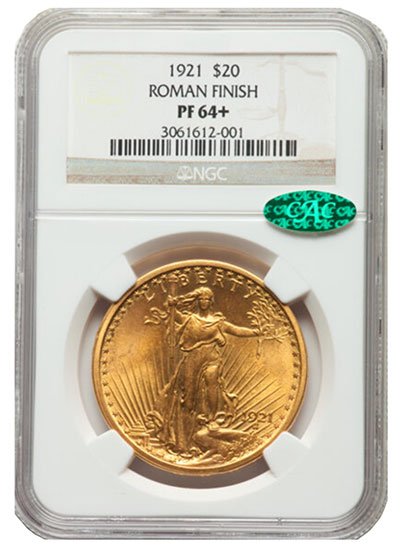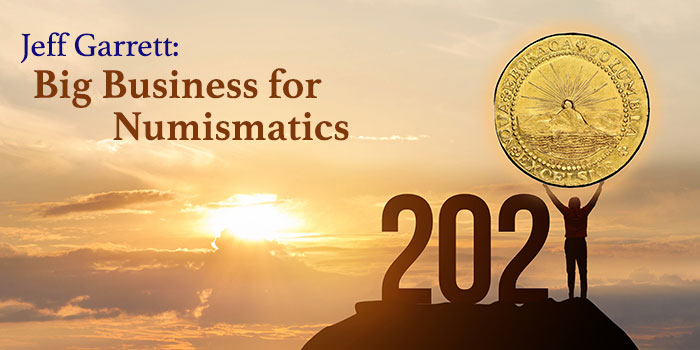The rare coin and bullion markets exceed previous years with astronomical numbers
By Jeff Garrett for Numismatic Guaranty Corporation (NGC) ……
There is no doubt that the rare coin and bullion market in the United States has evolved considerably in recent decades. Thirty years ago, when I operated an auction company, my mailing list consisted of about 5,000 names. Of those customers, around 1,000 would participate in a given sale. My last FUN auction in the 1980s realized less than $5 million.
Heritage Auctions reported over $300 million in sales for just the first quarter of 2021 alone, including an internet-only FUN auction of an NGC-graded Brasher Doubloon for over $9 million. Today, it is not unusual for 10,000 bidders to participate in an auction. Times have certainly changed!
A couple of years ago, someone asked me to estimate the size of the rare coin and bullion market in the United States. This is a tricky task, as there are no reporting requirements for numismatic sales in the United States. The government does not issue statistics for our business. People are not eagerly awaiting rare coin sales data from the government each month to judge whether the market is weak or hot. Most are probably happy the government does not collect this data, but it does leave one wondering how to estimate the size of the market. It’s clear that rare coins and bullion is a multi-billion-dollar business.
Numbers Speak Volumes
The following numbers are rough estimates but may prove helpful in understanding the size of the rare coin market. There are at least 5,000 active coin companies in the United States. They range in size from one-man operations to multi-national juggernauts with hundreds of employees. There are at least 10 to 15 companies with sales exceeding $100 million per year. APMEX alone touts annual sales approaching $2 billion or more.
The Professional Numismatists Guild (PNG) has around 300 members, most of which have large annual sales of numismatic material. There are also quite a few mass-marketing companies with annual sales of over $100 million. Many of these companies specialize in modern and world coins. The PNG also tracks total auction prices realized in the United States. The following information can be found on their website about sales during the pandemic year 2020:
Based on responses to a PNG questionnaire, “the aggregate prices realized for U.S. rare coins sold at major public auctions in 2020 totaled nearly $369 million. The aggregate total was $325 million in 2019; $345 million in 2018; and $316 million in 2017.”
“Major auction sales of U.S. banknotes in 2020 totaled $50.6 million bringing the combined aggregate auction sales of rare U.S. coins and paper money the past year to over $419 million.” This was the first year PNG included banknotes in its annual survey.
Why is This Important?
Almost everyone who collects rare coins or currency probably has at least some interest in the investment aspect. The overall size of the market is important to gauge how much new money is coming into our hobby. If the combined sales of every numismatic firm were to suddenly decrease each year, this would have a profound impact on prices. The very opposite has been the case in the last decade. The amount of money coming into the hobby each year must at least balance with the amount of fresh material offered.
 Recent auction results for high-end coins demonstrate that there are plenty of new buyers for the material being offered. I have seen many new faces bidding in these sales. There has also been interest from international players for many of the classic “trophy” coins that have sold in recent months. For now, it seems the market for rare coins is expanding.
Recent auction results for high-end coins demonstrate that there are plenty of new buyers for the material being offered. I have seen many new faces bidding in these sales. There has also been interest from international players for many of the classic “trophy” coins that have sold in recent months. For now, it seems the market for rare coins is expanding.
This will be tested in the next few weeks as the annual “bellwether” ANA convention and auctions take place. There is an astounding number of seven- and potentially eight-figure coins being offered for sale. One of my favorite coins being offered is an NGC PF 64+ 1921 Saint-Gaudens Double Eagle. The ANA convention, which did not take place last year, is one of the most hotly anticipated events in years. Hopefully, the recent spike in COVID-19 cases will not put a damper on the festivities.
The rare coin market is clearly the beneficiary of the improved “wealth effect” that seems to be influencing buyers. After crashing at the beginning of the COVID-19 crisis, the stock market has risen to record levels. Home prices are soaring in about every part of the country and consumer confidence has been on the rise. There is no doubt the rich have gotten richer. Trillions of dollars in new wealth have been created in the United States in just a few short years.
Luckily, many of these newly confident buyers seem attracted to numismatics. This new influx of money clearly has been a huge factor in the growth of the market for rare coins.
The size of the rare coin market is also important when trying to understand the impact of new government regulations that may affect the business. Many (including myself) have been concerned about the collection of state sales taxes across state lines aimed to level the playing field between brick-and-mortar stores and internet operations. So far, the rollout of the Wayfair ruling for the collection of sales tax has not stifled sales significantly. The industry owes a HUGE thanks to the National Coin and Bullion Association (formerly ICTA) for fighting to maintain sales tax exceptions in over 30 states.
For decades, there has been intermittent interest from money managers in the rare coin industry. Currently, there are at least a few funds with considerable capital devoted to trading rare coins from an investment standpoint. Understanding the size of the market for rare coins is an important element for anyone controlling funds that might be directed to numismatics. No one would be interested in investing in a thinly traded market. The fact that a multi-billion-dollar market exists is critical for those looking into rare coins.
The rare coin market is also among the most transparent of collectible fields. There is plentiful information available and third-party certification has added tremendous liquidity. Look for this trend to continue as wealthy investors are forced to seek alternative investments because of low fixed-interest investments and record stock prices.
It is quite funny how under the radar the rare coin business operates. I still get odd looks when I meet someone for the first time, and they ask what I do for a living. More than once, people have asked me if someone can make a living selling coins. Happily, I have been doing so for over 40 years!
* * *






